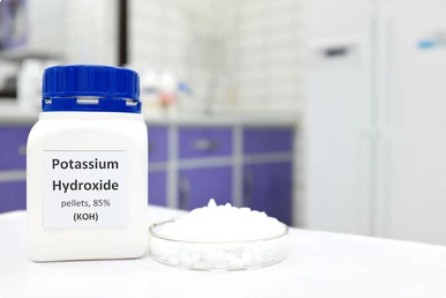- Home
- About Us
- Products
- Services
- Recommendation
- Industries
- Resource
- Order Center
- Contact Us
Potassium hydroxide (KOH), also known as caustic potash or potash lye, is an odorless, white solid that is highly hygroscopic, meaning it readily absorbs moisture from the atmosphere. It is highly soluble in water, alcohol, and glycerol, producing a strong alkali solution. The compound has a molecular formula of KOH and a molar mass of approximately 56.11 g/mol.

Structurally, potassium hydroxide consists of a potassium cation (K+) and a hydroxide anion (OH-). The hydroxide ion is formed by the combination of a single oxygen atom bonded to a single hydrogen atom, resulting in a negatively charged species. The potassium ion, on the other hand, carries a positive charge due to the loss of one electron.
Potassium hydroxide displays a wide array of reactions, making it a versatile compound in various chemical processes. Some notable reactions involving KOH include:
1. Neutralization Reactions: When combined with an acid, potassium hydroxide undergoes neutralization reactions, resulting in the formation of water and a potassium salt. For example, when KOH reacts with hydrochloric acid (HCl), potassium chloride (KCl) and water (H2O) are formed.
2. Dehydration Reactions: Due to its strong affinity for water, KOH is often employed as a desiccant, capable of removing water from various organic compounds.
3. Oxidation Reactions: Potassium hydroxide can initiate the oxidation of certain organic compounds. For example, it can be used as a catalyst in the oxidation of aldehydes to carboxylic acids, or in the oxidation of primary alcohols to aldehydes.
4. Saponification Reactions: KOH is commonly used in the saponification process, which is the hydrolysis of esters in the presence of an alkali. This reaction produces soap, glycerol, and the corresponding salt of the carboxylic acid.
5. Electrolysis: Potassium hydroxide is often used as an electrolyte in alkaline batteries. It facilitates the movement of ions and enables the battery to generate electricity.
Potassium hydroxide is primarily manufactured through the electrolysis of potassium chloride (KCl) in a process called the chloralkali process. Here is a step-by-step guide on how potassium hydroxide is manufactured:
1. Anode Compartment: In the anode compartment, a direct electric current is passed through the saturated salt solution. Chloride ions (Cl-) from the potassium chloride are oxidized at the anode, forming chlorine gas (Cl2).
2Cl- → Cl2 + 2e-
2. Cathode Compartment: In the cathode compartment, water molecules (H2O) are reduced at the cathode, forming hydrogen gas (H2) and hydroxide ions (OH-).
2H2O + 2e- → H2 + 2OH-
3. Hydroxide Formation: The hydroxide ions formed at the cathode react with the potassium ions (K+) present in the saturated salt solution, resulting in the formation of potassium hydroxide (KOH).
K+ + OH- → KOH
4. Separation and Concentration: The potassium hydroxide solution obtained from the electrolysis process is then separated from the remaining salt solution. The solution is concentrated by evaporating water under controlled conditions, leaving behind solid potassium hydroxide crystals.
5. Pellet Formation: The concentrated potassium hydroxide solution is further processed to form pellets or solid flakes. It is typically dried and then molded into the desired shape and size.
6. Packaging and Distribution: The potassium hydroxide pellets or flakes are packed into suitable containers, such as bags or drums, and then distributed to various industries.
1. Soap production: Potassium hydroxide is used in the production of liquid soaps due to its ability to react with fatty acids and form soaps. It is also used in solid soap production when combined with sodium hydroxide.
2. Fertilizers: Potassium hydroxide is used as a source of potassium in some fertilizers. It increases the availability of potassium to plants, which is an essential nutrient for their growth and development.
3. Food production: Potassium hydroxide is used as a food additive in some processes, such as cocoa processing. It helps in the separation of cocoa solids from cocoa butter.
4. Batteries: Potassium hydroxide is used in some batteries, such as nickel-cadmium batteries. It acts as an electrolyte, allowing the flow of ions between the electrodes and facilitating the battery's operation.
5. Pharmaceuticals: Potassium hydroxide is used as a reagent in the synthesis of various pharmaceuticals. It can be used to neutralize acidic compounds or facilitate chemical reactions during drug manufacturing processes.
6. Detergents: Potassium hydroxide is used as a component in some detergents due to its ability to remove grease and oils from surfaces.
7. Paint stripping: Potassium hydroxide can be used as a paint stripper due to its strong alkaline nature. It can dissolve or soften many types of paints, allowing for easier removal.
8. Cleaning products: Potassium hydroxide is used in various cleaning products, such as drain cleaners and oven cleaners, due to its ability to dissolve organic matter and remove tough stains.
9. Biodiesel production: Potassium hydroxide is used in the production of biodiesel as a catalyst for the transesterification reaction, which converts oils and fats into biodiesel.
10. Water treatment: Potassium hydroxide is used in water treatment processes to adjust pH levels, control acidity, and neutralize acidic substances in water.
Privacy Policy | Cookie Policy | Copyright © 2025 Alfa Chemistry. All rights reserved.
Back to top